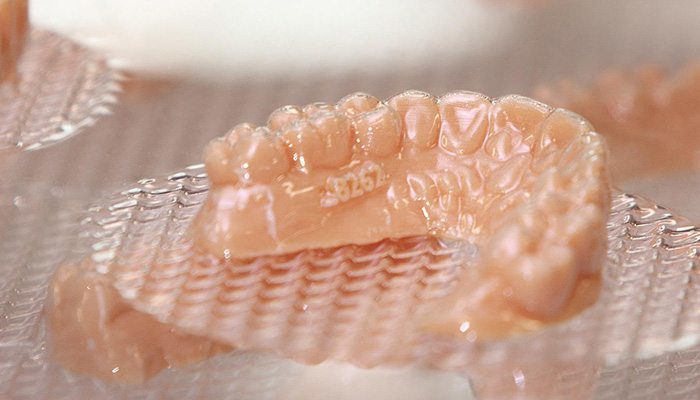“Since we began leveraging Stratasys 3D printing
technology, we’ve experienced faster turnarounds,
better capabilities and a vibrant, growing business.”– James Bonham, Specialty Appliances partner
Digital technology that combines intraoral scanners and 3D printers provides a faster, better
and more affordable means for creating an exact replica of a patient’s mouth. Advanced digital
labs like Georgia-based Specialty Appliances can deliver high-quality orthodontic appliances
in less time and create dental models at lower cost than the use of traditional stone models
made from dental impressions.
Using its Objet Eden260V™ and Objet Eden500V™ 3D Printers, and the machines’
VeroDentPlus™ material, Specialty Appliances, a full-service digital orthodontic laboratory,
cuts weeks from custom appliance development and creates more accurate, durable dental
models at lower cost, resulting in fewer appointments and shorter treatment time for patients.
3D Printing Revolutionizing Orthodontics
Arlen Hurt, vice president of Specialty Appliances, saw how 3D scanning,
modeling and printing technology could improve the field of orthodontics.
“Everything that we do in the development of an orthodontic appliance—whether
it be a palatal expander or a Herbst appliance to correct an overbite—is based on
a physical model,” Hurt explains. “With the advent of intraoral scanners, it became
clear that printing dental models with a 3D printer would be faster, more accurate
and less prone to human error than the traditional impression-based approach.”
Hurt adds that, “intraoral scanners and Stratasys® 3D Printers have allowed us to
deliver custom appliances a week sooner without the need to take impressions.”
Specialty Appliances added its first 3D printer — an Objet Eden260V 3D Printer
— in 2011 and a second Objet Eden260V a year later. As printer usage increased
from six percent of cases to 24 percent in just 18 months, the lab added a third,
an Objet Eden500V 3D Printer.
“We looked at and evaluated every printer on the market, but we were drawn to
Stratasys by its large number of references, easier approach to post-processing,
and fewer maintenance issues,” Hurt recalls. “Once our usage exploded, we
added the third printer because when you depend on a piece of equipment for
production, you need a backup to support rapid growth.”
Stone Models vs. 3D Prints
In addition to saving time—stone models take a week to produce from an
impression, while 3D printed models are made the same day that scan data
arrives—3D printing provides other important advantages over traditional stone
models. First, 3D printed models are more accurate and durable than stone
models, which are highly dependent upon obtaining a good quality impression
of the patient’s teeth. With their 3D printers, Specialty Appliances can produce
dental models from intraoral scan data with a resolution that is within 40
microns of dimensions of the patient’s actual teeth.
Because 3D printed dental models are more durable—they don’t crumble
and deteriorate like stone models—Specialty Appliances can make multiple
appliances from a single print. This makes them more affordable than the
traditional impression-based approach, which requires additional stone models
to create additional appliances. The 3D printed dental models also offer increased
accuracy and durability.
“Thirty years ago, nobody would have thought that this was possible,” says
Hurt, but with advances in materials and productivity gains, “we know where
our business is headed, and that 3D printing will play an important role in our
growth and success.”
Fewer Appointments, Less Treatment Time
One of the most notable benefits is the need for fewer appointments and less
treatment time for patients. In other words, patients can get their braces off sooner
and avoid potential relapse or movement of the teeth between procedures.
“Taking impressions can consume entire appointments,” notes James Bonham,
a Specialty Appliances partner who manages sales and marketing. He says that
3D printing shortened a typical procedure—like mounting an appliance through
a band or crown seated on the molars—from six weeks and three appointments
to two weeks and two appointments. “Everyone benefits: the orthodontist, his
staff and most importantly, the patient.
“Stratasys 3D Printers have helped us carve out a unique spot in the
marketplace by enabling us to provide services to customers in a digital 3D
world,” Bonham continues. “Since we began leveraging Stratasys 3D printing
technology, we’ve experienced faster turnarounds, better capabilities and a
vibrant, growing business.”
